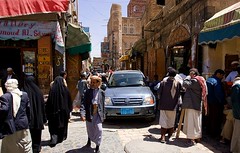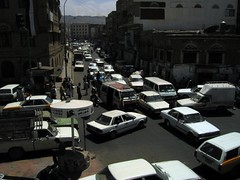Most westerners hated driving in Yemen. All western men hated driving in Yemen. I loved driving in Yemen.
I bought a two-door Rav 4 from a member of the French embassy. He wasn't leaving Yemen, but he had concluded the two-door version was too small. He needed to sell his car to a diplomat so he could buy a four-door version without having to pay duty on one of them. I won big with that baby car. It had an incredibly tight turning radius that made it possible to make a U-turn almost within the length of the car itself. I could park almost anywhere. Not only was the car short, it was also narrow which meant I could squeeze it down the paths within the souq. What wasn't to love?
There were some downsides to having such a small car. If I forgot where I parked it, I couldn't expect to find it by scanning a parking lot or the side of streets for something sticking out that I could recognize. I had to walk right up to it to be sure it was still there.
Most of our housing was a good 30-minute drive from the embassy. For those who hated driving in Yemen, that meant two half-hour periods of intense pressure each day. But for me, it was like going to work through an amusement park. Sanaa's main streets were ring roads around the edge of the city with spokes from the center of the city connecting them. That made it possible to get from one side of town (where we lived) to the other (where we worked) by heading in opposite directions. And one route didn't take all that much longer than the other.
One of the first security tips I learned when joining State was to vary both times and routes, especially when going to work. Most terrorists attacks that had targeted specific individuals were possible because the targets were predictable. To avoid being predictable, I developed a game for myself. I would leave for work at least an hour before I needed to arrive, but never at the same time two days in a row. At each intersection, I decided whether to turn left or right depending on whether the car I saw closest to the intersection was black (left) or white (right). If it was any other color, I went straight ahead. No one could predict my route because even I didn't know my route ahead of time. It developed as I drove. And I learned my way around the city fast.
One evening on my way home, the game led me out of town further than usual. I reached a police roadblock - they were common outside of cities - and needed some directions to get me back into familiar territory. Maybe I should have been worried, but I had my guardian angel who kept harm away from me.
The key difference between my approach to driving and every other westerner's was that I adapted to the local system. Western drivers tried to drive defensively by using their mirrors to look at everything around them. They stressed out trying to keep track of all the unpredictable behaviors. But the locals only paid attention to what was ahead of them. The one accident a driver was expected to avoid in Yemen was running into the back of the car ahead. When an accident occurred, the first question the police asked was, "Who was in front?" The person in front was never at fault. I know because one evening when I was more upset than usual, I was alongside a truck at a roundabout and before I realized it, he had sideswiped my car - just minor damage, but damage. I had to pull over to the side of the street and radio the embassy to ask that they send one of the roving patrol guards to help me translate. Since the truck was alongside my car, but it was bigger than my car, the police determined the truck was ahead of me and not at fault.
|
I didn't stick to streets as I drove. There were alleys and fields, never flat and some full of rocks or water. But my Rav 4 got me through them all. One area I didn't drive on but passed often was a stretch of road where grain would be spread at one edge so that carts could be driven over it in order to separate the grain from the chaff. The carts may have been a bit more modern than what was used during Biblical times, but the image was straight out of two millennia before.
I compared driving in Yemen to dancing as the vehicles floated without regard for lines dividing lanes. In contrast, driving in the U.S. is like marching, with every car lined up within the lanes, and enough space between them for the drivers to be confident there won't be a collision. Personally, I prefer dancing.

 by ck-cabrio_creativelabs
by ck-cabrio_creativelabs 
 by fveronesi1
by fveronesi1 
No comments:
Post a Comment